

5D optical memory in glass could record the last evidence of civilization. Public release date: 9-Jul-2013 [ Print | E-mail Share ] [ Close Window ] Contact: Glenn HarrisG.Harris@soton.ac.uk 44-023-805-93212University of Southampton Using nanostructured glass, scientists at the University of Southampton have, for the first time, experimentally demonstrated the recording and retrieval processes of five dimensional digital data by femtosecond laser writing.
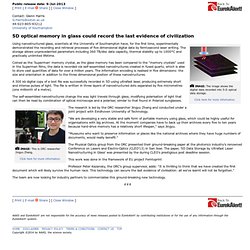
The storage allows unprecedented parameters including 360 TB/disc data capacity, thermal stability up to 1000°C and practically unlimited lifetime. Australian Scientists Develop Printable A3-Sized Solar Cells. Solar energy sounds like a dream, but buying and installing the equipment necessary to harness the power of the Sun can be expensive.

But what if you could print your own solar panels? The researchers at Australia's Victorian Organic Solar Cell Consortium (VICOSC) — a collaboration between the Commonwealth Scientific and Industrial Research Organisation (CSIRO), the University of Melbourne, Monash University and industry partners — have managed to print photovoltaic cells the size of an A3 sheet of paper. "There are so many things we can do with cells this size.
High-power lithium ion microbatteries from interdigitated three-dimensional bicontinuous nanoporous electrodes. Scalable High-Power Redox Capacitors with Aligned Nanoforests of Crystalline MnO2 Nanorods by High Voltage Electrophoretic Deposition - ACS Nano. Multi-Scale Energy Systems (MuSES) Laboratory, Department of Mechanical Engineering - Engineering Mechanics, Michigan Technological University, Houghton, Michigan 49931, United States ACS Nano, 2013, 7 (3), pp 2114–2125 DOI: 10.1021/nn3044462 Publication Date (Web): February 1, 2013 Copyright © 2013 American Chemical Society Section: Abstract.

Piezoelectric 'taxel' arrays convert motion to electronic signals for tactile imaging. Using bundles of vertical zinc oxide nanowires, researchers have fabricated arrays of piezotronic transistors capable of converting mechanical motion directly into electronic controlling signals.
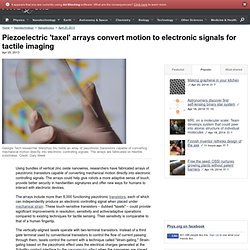
The arrays could help give robots a more adaptive sense of touch, provide better security in handwritten signatures and offer new ways for humans to interact with electronic devices. DNA strands that select nanotubes are first step to a practical 'quantum wire' DNA, a molecule famous for storing the genetic blueprints for all living things, can do other things as well.
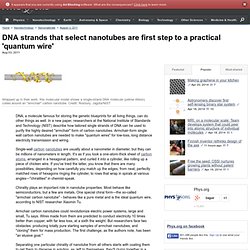
In a new paper, researchers at the National Institute of Standards and Technology (NIST) describe how tailored single strands of DNA can be used to purify the highly desired "armchair" form of carbon nanotubes. Armchair-form single wall carbon nanotubes are needed to make "quantum wires" for low-loss, long distance electricity transmission and wiring. Scientists reach the ultimate goal: Controlling chirality in carbon nanotubes. An ultimate goal in the field of carbon nanotube research is to synthesise single-walled carbon nanotubes (SWNTs) with controlled chiralities.

Twenty years after the discovery of SWNTs, scientists from Aalto University in Finland, A.M. Prokhorov General Physics Institute RAS in Russia and the Center for Electron Nanoscopy of Technical University of Denmark (DTU) have managed to control chirality in carbon nanotubes during their chemical vapor deposition synthesis. Scientists 'clone' carbon nanotubes to unlock their potential. (Phys.org)—Using a new method, researchers can now grow carbon nanotube semiconductors of predefined structures, which may pave the way for carbon to be used in future electronics.
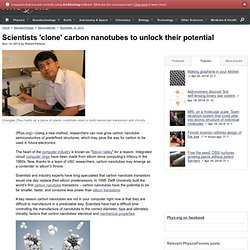
The heart of the computer industry is known as "Silicon Valley" for a reason. Integrated circuit computer chips have been made from silicon since computing's infancy in the 1960s. Self-Powered System with Wireless Data Transmission - Nano Letters. School of Material Science and Engineering, Georgia Institute of Technology, Atlanta, Georgia 30332-0245, United States Nano Lett., 2011, 11 (6), pp 2572–2577 DOI: 10.1021/nl201505c Publication Date (Web): May 23, 2011 Copyright © 2011 American Chemical Society + Author Contributions These authors contributed equally to this work.

Section: Cree Sets New Record for White LED Efficiency. LED's efficiency exceeds 100% (PhysOrg.com) -- For the first time, researchers have demonstrated that an LED can emit more optical power than the electrical power it consumes.
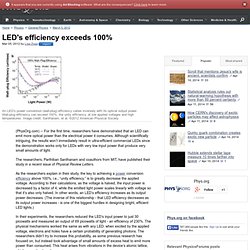
Although scientifically intriguing, the results won’t immediately result in ultra-efficient commercial LEDs since the demonstration works only for LEDs with very low input power that produce very small amounts of light. The researchers, Parthiban Santhanam and coauthors from MIT, have published their study in a recent issue of Physical Review Letters.
As the researchers explain in their study, the key to achieving a power conversion efficiency above 100%, i.e., “unity efficiency,” is to greatly decrease the applied voltage. According to their calculations, as the voltage is halved, the input power is decreased by a factor of 4, while the emitted light power scales linearly with voltage so that it’s also only halved. Mechanically induced intramolecular electron transfer in a mixed-valence molecular shuttle. A Molecular Shuttle Driven by Fullerene Radical-Anion Recognition - Scarel - 2012 - Chemistry - A European Journal. Synthesis and Single-Molecule Imaging of Highly Mobile Adamantane-Wheeled Nanocars - ACS Nano. Just stick this portable outlet to your window to start using solar power. Nanoscale MRI being developed.
(Phys.org)—Two independent groups of scientists in the U.S. and Germany have reduced magnetic resonance imaging (MRI) down to the nanoscale, which may enable them in the future to non-destructively detect and image small molecules such as proteins at room temperature and pressure.

Previously, nanoscale imaging was only possible at extremely low temperatures and pressures. MRI works through detecting weak electromagnetic fields produced by the nuclei of atoms such as hydrogen within the molecules being studied, and the collective resonance of these fields. It is able to image structures without destroying them, which makes it useful for scanning bodies, but its relatively low sensitivity has up to now restricted its use on the small scale to chemicals with volumes measured in micrometers at best. Two papers published in the journal Science describe the research done by the two separate groups, which both used dark spots, or nitrogen-vacancy (NV) defects, on the surface of diamonds. A 3D Printed Spaceship On The Scale Of A Human Hair? Hello Nanoscribe 3D Printer.
3D printing has become one of the most exciting and talked about technologies of 2013. The ability for the masses to make almost any object not only fuels imagination but challenges modern consumerism and its supply chain. While some enthusiasts continue to showcase the technology by producing toys, cars, and even guns in their garage, others look to 3D printing to manufacture the next generation of electronics, whether for mobile applications, medical devices, or wearable computing. Regardless of the application, the challenge in manufacturing at the submicron scale is fabricating structures in a precise, rapid, and consistent fashion. Even though 3D printing is just getting started, the race for the fastest, most capable printer is already on. Super yarn in works for space suits, bulletproof vests - Technology & science - Innovation.
Super-strong, highly conductive yarns made from extraordinarily thin carbon tubes could one day find use in spacesuits, bulletproof vests and radiation suits, researchers now suggest. Carbon nanotubes are hollow pipes just nanometers or billionths of a meter in diameter — dozens to hundreds of times thinner than a wavelength of visible light. They can possess a range of extraordinary physical and electrical properties, such as being roughly 100 times stronger than steel at one-sixth the weight. Scientists have feverishly explored ways to make textiles from carbon nanotubes for years.
However, yarns made from these nanotubes lacked the attractive properties seen in lone fibers. The problem is rooted in how the nanotubes are typically about 200 to 400 millimeters long. Graphene Supermarket. Mass production of high quality graphene: An analysis of worldwide patents.
Nanocapsules Sober Up Drunken Mice. Researchers have reduced blood alcohol levels in intoxicated mice by injecting them with nanocapsules containing enzymes that are instrumental in alcohol metabolism. The treatment demonstrates a novel drug delivery technology that could have broad medical applications. Enzymes are proteins that catalyze a wide range of biological processes in the body, making them attractive candidates as therapeutics. Many important biological functions require precisely arranged groups of different enzymes working in concert, often inside a cellular subcomponent called an organelle.
Though researchers have tried for years to develop such complexes in the lab, it has proved extremely difficult to maintain stable proteins and precisely control their size and arrangement.